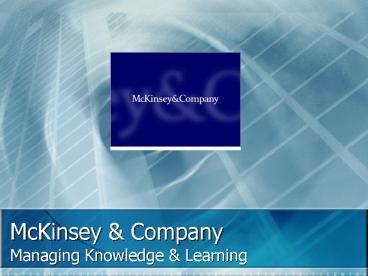McKinsey
1 / 26
Title: McKinsey
1
McKinsey Company
- Managing Knowledge Learning
2
From the beginning
- Founded in 1926 by James Mac McKinsey
- An integrated approach McKinsey called his
General Survey Outline - an analysis of a companies goals, strategies,
policies, organization, facilities, procedures,
and personnel
3
From the Beginning
- One Firm Policy
- Requires consultants to be recruited and advanced
on a firm-wide basis, clients be treated as a
McKinsey Company responsibilities, and profits
be shared from a firm pool, not an office pool.
4
From the Beginning
- Every assignment should bring the firm something
more than revenue - Experience
- Prestige
5
From the Beginning
- Extraordinary domestic growth through the 1950s
provided a basis for international expansion that
accelerated the rate of growth in the 60s. - Offices were opened in
- London, Geneva, Amsterdam, Dusseldorf, and Paris.
6
Growing Concern
- The economic turmoil of the oil crisis
- Slowing of the divisionalization process
- Growing sophistication of client management
- Entrance of new competitors like Boston
Consulting Group (BCG)
7
Steps to Change
- Commission on firm Aims and Goals 1971
- The firm had been growing too fast
- Our preoccupation with the geographic expansion
and new practice responsibilities has caused us
to neglect the development of our technical and
professional skills - Too willing to take routine assignments from
marginal clients and the quality of work done has
been uneven. - Consultants lacked the deep industry knowledge or
specialized expertise that clients were
demanding.
8
Steps to Change
- Recommit itself to the continuous development of
its members. - Slow growth
- Associate to MGM ratio be reduced from 7 to 1
back to 5 or 6 to 1.
9
Steps to Change
- Emphasize T-Shaped consultants those who
supplemented a broad generalist perspective with
an in-depth industry or functional specialty.
10
Steps to Change
- Appoint a full-time director of training
- Training and development of consultants
- Move towards a product driven approach
- Create industry-based Clientele Sectors in
consumer products, banking, industrial goods,
insurance, and so on
11
Steps to Change
- Assemble working groups in two areas
- Strategy
- Organization
- Knowledge development
- Ongoing and institutionalized
- 15 centers of competence to help develop
consultants and the ensure the continued renewal
of the firms intellectual resources
12
Steps to Change
- Change the internal status hierarchy
- Snowball making practice development,
internal effort for improving knowledge - Snowball throwing client development,
external consulting - Everyone must become snowball makers and snowball
throwers
13
Building a Knowledge Infrastructure
- McKinsey Staff Paper series (1978)
- Consultants published key findings. The problem
was that this was too time consuming. - Practice Bulletins
- Two page summaries of important new ideas that
identified the experts who could provide more
detail.
14
Building a Knowledge Infrastructure
- Knowledge Management Project (1987)
- The firm had to build a common database of
knowledge accumulated from client work and
development. - Each practice area (Clientele Sector and
Competence Sector) must hire a full time practice
coordinator who could ask as an intelligent
switch - The firm had to expand its hiring practices and
promotion policies to create a career path for
deep functional specialists whose narrow
expertise would make them more I-shaped than the
normal profile of a T-Shaped consultant
15
Building a Knowledge Infrastructure
- Firm Practice Information System
- Computerized database of client engagements
- Computer based Practice Development Network
(PDNet)
16
Building a Knowledge Infrastructure
- The Knowledge Resource Directory (KRD)
- A listing of all firm experts and key document
titles by practice area
17
Building a Knowledge Infrastructure
- From T-shaped to I-shaped Consultants
- Transition to deep functional specialists with
narrow expertise - Cause some uncomfortable feelings for the firm
and some technical expertise consultants
18
Building a Knowledge Infrastructure
- The knowledge infrastructure and transition of
KcKinsey Company led to a revived growth and
new offices in Rome, Helsinki, Sao Paulo, and
Minneapolis. - 41 offices now
19
Refining Knowledge and Management
- Ted Hall weeds Glucks garden of 1,000 flowers
- Replaced the leader-driven knowledge creation and
dissemination process with a stewardship model
of self-governing practices focused on competence
building. - Integrating groups and knowledge Sectors into 7
Functional Capability Groups.
20
Client Impact
- CPDC Clientele and Professional Development
Committee - All Partners Conference Client Impact Committee
- Shift from Engagement Team (ET) to the Client
Service Team (CST) - Add long term value and increase the effectives
of individual engagements
21
Three Consultant Profiles
- Jeff Peters, Sydney Office
- John Stuckey assembles a 5 member team for a
financial industry project in Australia - Group leverages the international knowledge of
the Firm to create a great set of recommendations
for client. - Is McKinsey becoming too introverted?
22
Three Consultant Profiles
- Warwick Bray and European Telecoms
- Exhibits inter-cooperation between branch offices
and the companies Intranet. - Can using information from other sectors pose
danger?
23
Three Consultant Profiles
- Stephen Dull and the Business Marketing
Competence Center - Developed Business to Business (BtoB) Initiative
- New competence center focused on cutting-edge
issues in marketing. (e.g. segmentation,
multi-buyer decision making, and marketing
partnerships). - Is technology eroding personal relationships?
24
A New Focus
- Rajat Gupta becomes MD (1994)
- Capitalize in the firms long term investment in
practice development driven by Clientele Industry
Sectors and Functional Capability Groups
supported by PDNet and EPIS. - Practice Olympics
- Knowledge development approach
- Six special incentives
- Expand on the model of the McKinsey Global
Institute, a firm sponsored research center. - Change center and operations center
25
Technopoly
- The Dark Side to Technology and how Mckinsey can
avoid it.
26
Future Directions
- http//youtube.com/watch?v9J18vf5Ey2Q











![[PDF] The McKinsey Way](https://s3.amazonaws.com/images.powershow.com/10100137.th0.jpg?_=202408160511)



















